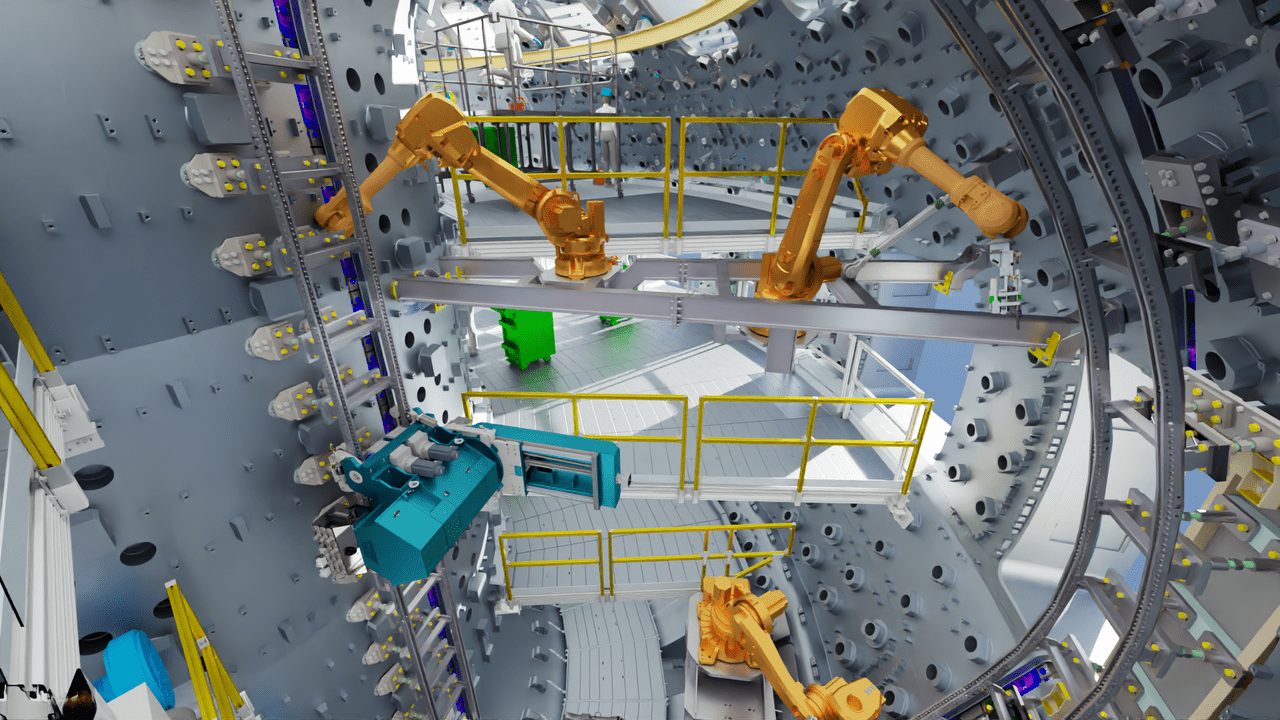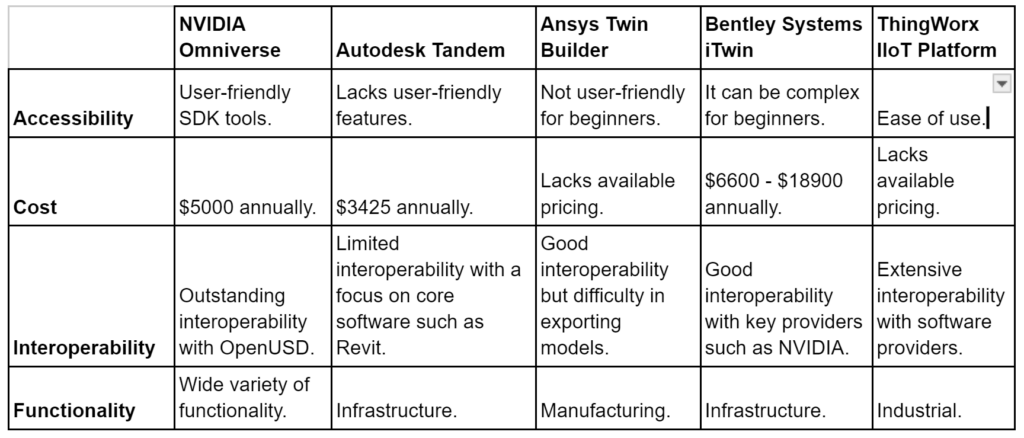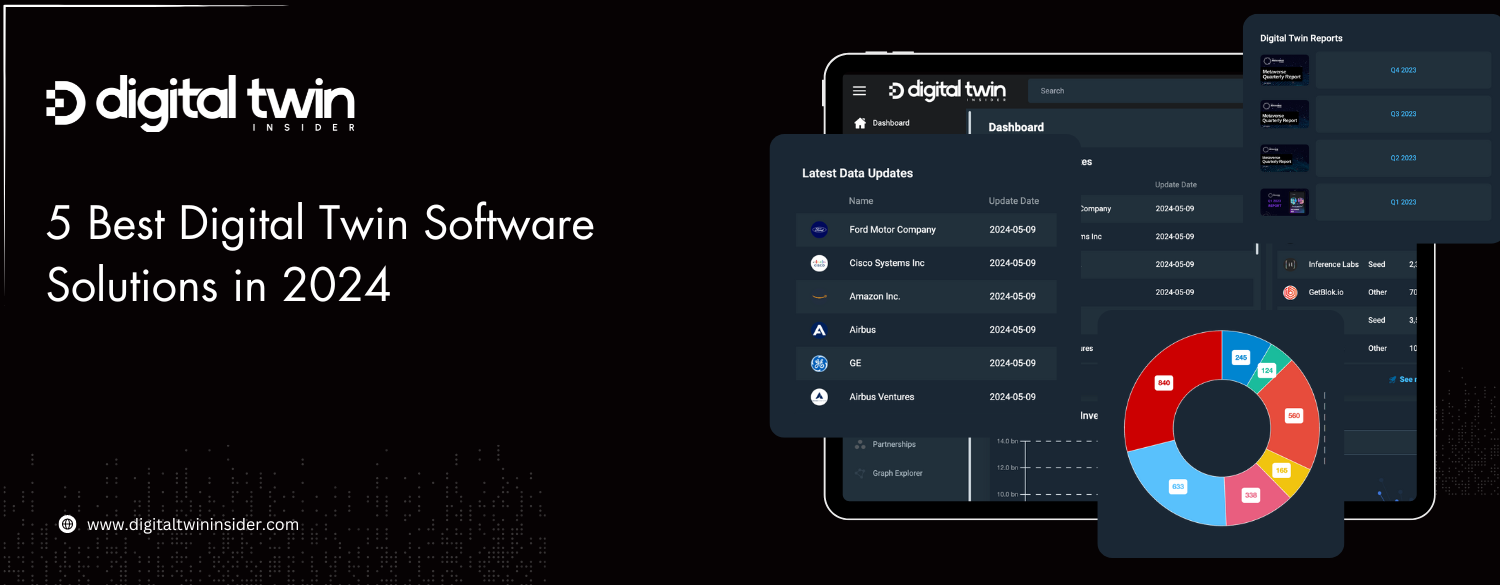Introduction
Software solutions underpin the digital twin market. In short, digital twins are software that simulate realistic, 1-1 digital replicas in real time that use and feed instantaneous data feedback.
This article will explore the myriad of digital twin software solutions currently available, specifically focusing on platforms that offer all-encompassing solutions. The core goal of this article is to inform end users about the best software available, helping them make the right choice when developing digital twins.
Top 5 Digital Twin Software Solutions
1. NVIDIA Omniverse
Although not a single digital twin software solution, NVIDIA Omniverse is a key software used by global leaders, such as Siemens, Hyundai, and Delta Electronics, to create digital twins. Omniverse is an accumulation of different software that assists these twins’ development.

Omniverse consists of platform SDKs that enable users to build digital twins from conception to reality with a range of easy-to-access software applications that require no code. Likewise, the platform’s integration with Open USD ensures interoperability with other software provided by external partners.
Examples include integrating Autodesk 3ds Max and Revit software and the Cesium platform to develop 3D models. The number of software integrations with Omniverse is numerous, with leading companies working with NVIDIA to continue to support the platform. Furthermore, the RTX-powered platform can host digital twins via the Omniverse Cloud, giving users flexibility in their approach to using their digital twins solutions. NVIDIA also adopts cutting-edge security measures across its products, including Omniverse, to protect users and has integration with the likes of Apple Vision Pro to enhance immersion.
NVIDIA Omniverse Enterprise costs $5000 annually and offers a 30-day free trial. Despite its high price tag, Omniverse has received generally positive reviews, with users praising its ability to create 3D workflows easily.
Pros:
- User-friendly SDK tools.
- Outstanding interoperability with OpenUSD.
- End to end solution for developing digital twins.
- Integration with numerous software providers.
- Immersive visualization and integration using XR.
Cons:
- Heavy price tag.
- Requires a powerful PC to run.
- Some performance issues.

2. Autodesk Tandem
Autodesk Tandem is another key software solution in the digital twin industry. Like most solutions, digital twin software consists of different software layers and integrations. Autodesk Tandem enables companies to create digital twins using software Autodesk has developed to simulate data-rich 3D workflows. Autodesk Tandem allows integration with BIM software such as Revit and IFC models to import models and deploy sensors to create a digital twin.
This software solution consists of two core features: Twin Building, creating 3D workflows, and Insightful Operations, the digital twin’s connection with the real world to generate insights.
Currently, Autodesk offers a 14-day free trial of Tandem, with the software’s price being $3425 annually. Autodesk Tandem has been well received due to the depth of insights provided by the platform and staff support. Conversely, criticism has been targeted towards the platform’s ease of use and the need for better user-friendly features such as tutorials.
Pros:
- Cheaper price compared to competitors’ solutions.
- In-depth features.
- Great customer support.
Cons:
- Lacks user-friendly features.
- It can be complex to use.
- Limited interoperability with a focus on core software such as Revit.
3. Ansys Twin Builder
The Ansys Twin Builder enables customers to build, connect, and scale digital twins and provides key data on their twins, giving valuable insight. This digital twin software solution integrates a multidomain system modeler (MOD) alongside ROM, 0D libraries, and physics to create cloud-based digital twins with flexibility across project sizes.
Ansys Twin Builder is compatible with standard programming languages and has software integration with Azure Digital Twins, AWS, Rockwell Automation, and more.
Ansys Twin Builder offers a 30-day free trial with limited pricing information. However, you can use the platform for a couple of hours for $240. Manufacturing companies use Twin Builder, such as Kärcher, to create digital twins for battery production.
Reviews for this digital twin software have been positive, with users reporting quick development time and great features. Still, with difficulty exporting models and a lack of ease of use, the platform is short of its full potential.
Pros:
- Great software integration
- In-depth features and quick development
Cons:
- Lacks available pricing
- Difficulty in exporting models
- Not user-friendly for beginners
- No free trial
4. Bentley Systems iTwin
Well-known developer Bentley Systems has created its software solution, iTwin, to develop digital twins. Geared toward infrastructure companies, iTwin consists of layers of Bentley Systems software, such as iCapture, for capturing data in the real world combined with iTwin IoT (sensors-led data) for an intuitive and comprehensive digital twin platform. iTwin enables users to visualize their projects in real-time, increase ROI, and boost the efficiency of operations through interaction with their digital twins. The platform also integrates with NVIDIA Omniverse and has a range of user-friendly APIs.
Bentley Systems offers a range of pricing options for customers, and are tiered:
- A free 90-day trial
- Basic: $550 monthly, $6600 annually
- Premium: $1575 monthly, $18900 annually
- Custom package.
The tiers vary depending on the platform credits you receive. For example, in the premium package, you get 1500 monthly credits for $1.05 a credit. One of these credits can be spent on visualization for one hour to name but a few applications. For more information on the system, check out the Bentley website.
Customers have given iTwin positive reviews, citing its excellent features and in-depth simulation; however, the pricing for this software is hefty price.
Pros
- Great selection of features and excellent visualization tools.
- Integration with key providers such as NVIDIA.
- Lengthy free trial.
- Limited computer specifications are needed.
Cons
- Hefty price tag
- It can be complex for beginners

5. ThingWorx IIoT Platform
ThingWorx is a digital twin platform developed by PTC to remove issues associated with industrial IoT solutions that often plague implementation. ThingWorx features a low-code, developer-friendly platform that gives industrial customers what they need to deliver end-to-end solutions for digital twins. This digital twin software solution features a range of tools and features, such as augmented reality integration, to take visualization to the next level.
ThingWorx can be used in engineering and manufacturing. Although pricing is unavailable, reviews have been positive, citing its industry-leading features and extensive integration with software providers. ThingWorx features extensive security split into design and run-time security, providing users with permissions for who can access projects.
Pros:
- Extensive integration with software providers.
- Ease of use.
- Immersive visualization and integration using AR.
Cons
- Lacks pricing structure.
- Reportedly lacks some data support.
- No free trial.
Digital Twin Software Solutions – Comparison Table

Choosing the Right Digital Twin Software
Choosing the right digital twin software comes down to your needs and preferences. The above list has featured platforms offering end-to-end solutions across industries. However, certain software solutions will cater better to specific needs. For example, Bentley Systems iTwin is heavily focused on infrastructure, while NVIDIA Omniverse has a more generalized focus, with the platform able to develop everything from games to manufacturing simulations.
Likewise, budget comes into play here with more specialized platforms like iTwin offering advanced bespoke infrastructure tools at a higher price tag. Thus, your budget plays a major role in your chosen solution, as these platforms become pricey after annualization. Luckily, most of the providers offer free trials for their digital twin solutions.
The level of external software integration is also worth noting. Interoperability is key in ensuring that your chosen platform can access the latest software tools.
Read also: Top 8 Digital Twin Platforms In 2024
Future Trends in Digital Twin Technology
The digital twin market is becoming heavily saturated with providers offering digital twin software solutions to customers. Due to increased saturation, end users need clarification regarding what solutions they should opt for. In the future, as the industry continues to mature, we should expect to see digital twin technology become more accessible for companies wanting to build their own, with interoperability platforms like NVIDIA Omniverse leading the way in providing end-to-end, easy solutions that companies can pick up without having to take a master’s degree in programming.
Read also:
Likewise, another trend is the continual evaluation of digital twins and their success in improving operational efficiency. We have yet to see comprehensive reports on the ROI and benefits these twins bring to industries, with available data spread over the internet and not in a convenient place for end users to make informed decisions. The Digital Twin Insider has been gathering data on this. Alongside the ever-growing list of use cases, Digital twins will continue to play a role in tackling some of the greatest challenges of our time, such as climate change.
Conclusion
In conclusion, this article has laid out the best digital twin software solutions on the market. For a more in-depth look at these solutions and providers, check out our intelligence platform for the latest data, insights, and ROI’s.













